The postal service’s role in our everyday lives has changed so much that it is hard to imagine how important the postal service was to people years ago.
With email, digital publications, and online bill pay, we simply do not “get the mail” as we used to. But imagine a small community emerging from sugar sand and pine woods – fledging Westpalmbeach, as it was spelled then, a little sister to the grand resort of Palm Beach. The post office that emerged has seen its share of unusual characters serve as postmaster, sometimes with tragic results.
When John C. Stowers arrived on the scene, fresh from adventure mining for gold in the Black Hills of the Dakotas, he wanted to open a grocery store. The Maine-born man could see that the community needed a post office, so he applied for one on March 8, 1894 with the Post Office Department in Washington D.C. On April 17, 1894, Stowers was appointed postmaster of Westpalmbeach and opened the first post office in a tent at the corner of Clematis and Narcissus.  On his lots, Stowers planned to construct a wooden building with space for his post office and a grocery store on the first floor, and office space on the second; but the need for hotel space led him to instead build the Palms Hotel, with a space for the post office and other shops on the ground floor.
On April 11, 1895, West Palm Beach had its first real post office building. West Palm Beach saw two tragic fires in 1896, and many blamed the town’s name as it had 13 letters; it was about this time that the name was officially changed to West Palmbeach, and finally, West Palm Beach on postal records. Stowers served 16 years as postmaster, and was succeeded by J. Paul Clarke on March 2, 1910.
Clarke would achieve his fame not from postal work, but from his work with poisonous snakes, which he kept at the post office and in a museum adjacent to his house on Rosemary Street. More about that later.
The third postmaster was appointed November 29, 1913 and was a man all in the community knew – Guy Metcalf, who published the area’s first newspaper The Tropical Sun, put in the first road to Miami, and sold real estate through his Tropical Exchange Company. With Metcalf, the post office gained a new home. Metcalf’s father, Judge W.I. Metcalf, built an office building at 107-109 North Olive Street, and rented out space for the post office on the first floor.
The Metcalf Building still stands; it was remodeled twice as part of Hatch’s department store, then the first J.C. Penney in West Palm Beach in 1940,  and later  in 1950 it was remodeled again into a Burdine’s store. Metcalf’s tenure as postmaster was short; he was succeeded by J.D. Argyle. Guy Metcalf, who was elected the Palm Beach County Superintendent of Public Instruction, died tragically in 1918 when he committed suicide in his courthouse office over a disputed bill.
In 1920, West Palm Beach had its first woman postmaster in Miss Lena M. T. Clarke, Paul Clarke’s younger sister. She had served many years as assistant postmaster, and served a couple of stints as acting postmaster, and was finally appointed to the top spot. But after Paul Clarke died from a coral snake bite on Christmas Day, 1920 in his makeshift museum, Lena’s life began a downward spiral. A rumored affair with a married man left her scorned and looking for revenge – she found it when she shot her alleged former lover and fellow postal employee Fred Miltimore dead on August 1, 1921 in Orlando. Postal authorities immediately removed Lena from the postmaster position and she was replaced with C.W. Campbell. Lena Clarke was eventually found not guilty of murder by reason of insanity (see this blog for a more detailed account of the Clarke murder case).
As West Palm Beach prospered, the post office outgrew the Olive Street location. Larger quarters were built at Datura and Railroad Avenue (today’s Quadrille). The Post Office Arcade housed the post office and other businesses such as real estate offices. Being housed near the post office was a selling point in many real estate ads. With the new building came new postmaster George W. Smith. This post office served West Palm Beach through its “Land Boom” years in the 1920s.
The 1928 Okeechobee hurricane and the 1929 Wall Street crash swept away all the big plans and big money from West Palm Beach. In 1934 O.B. Carr was named postmaster at the height of the Depression. It was about this time that West Palm Beach started lobbying the federal government to build a dedicated post office. Work began on the selected site at Olive Street and Fern in July 1936. The land chosen had a storied history, being a part of the original homestead declared by Irving R. Henry, who was the first to claim land in what would become West Palm Beach. John B. Beach eventually acquired the land. Beach, a nurseryman, raised tropical fruit trees for sale at his large nursery on the site. His widow, Annie Beach, presented the deed back to the federal government, 47 years after it had been deeded to Henry. The Beach house was demolished and rare plants and trees were moved to other locations in the city.
Officials laid the cornerstone made of Stone Mountain, Georgia granite on October 31, 1936 at a ceremony with dignitaries present. A sealed lead box with documents of the time was placed in the cornerstone. The Palm Beach Post wrote “Local historians of the future may open the post office cornerstone in years to come… .” Construction continued on the modern concrete and granite building, taken from a California design made to withstand earthquakes – and hurricanes. On May 1, 1937, the new building was ready for business. That building served West Palm Beach for many decades as both a service office and sorting facility.
As the 1960s came to a close, once again the need for a new post office developed. Representative Paul G. Rogers was instrumental in seeking funding for a comprehensive federal building and post office for West Palm Beach. A new post office was constructed at 801 Clematis Street, just west of the new Federal Building, named the Paul G. Rogers Federal Building; that site now houses the Social Security Administration building. Finally, the current post office at 640 Clematis Street serves downtown West Palm Beach.
The 400 South Olive Street building stood abandoned for years until 1979, when it was demolished to make way for affordable housing for older citizens as the St. James Residence to adjoin the St. Andrew’s Residence. What became of the cornerstone and the lead box with the documents remains a mystery as no mention of the artifacts appeared in the newspaper. Either it went unnoticed by the demolition crew or was taken by a worker as a souvenir.
Through all these locations, the same services as over a century ago are provided – mailing packages, purchasing stamps, picking up the mail; but something has been lost from those early days of the post office. The anticipation of a letter from far away, a catalog with the newest fashions, or an eagerly awaited magazine with the latest gossip is now instantly available to us. The ghosts of those old post office buildings still haunt their original locations with excitement, or dread, and the hope of good news.
Sources:
The Palm Beach Post
The National Archives
The University of Florida
Historical Society of Palm Beach County
The Mandel Public Library, West Palm Beach
The United States Postal Service
For a complete list of West Palm Beach Postmasters please see this web page: Postmasters of West Palm Beach




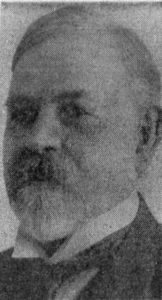
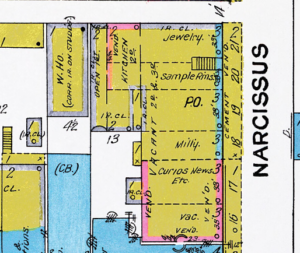
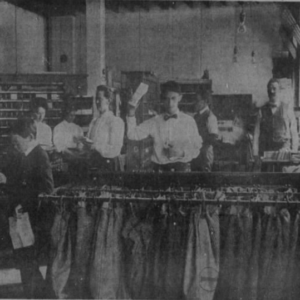
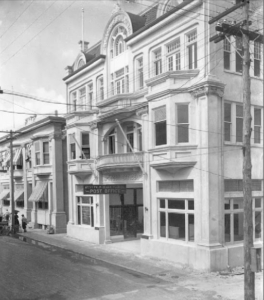
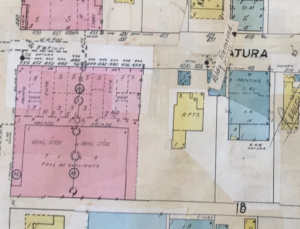
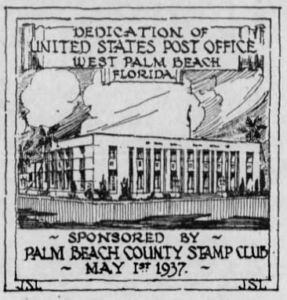
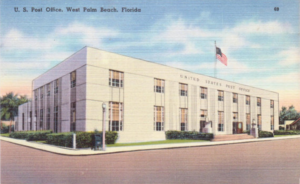
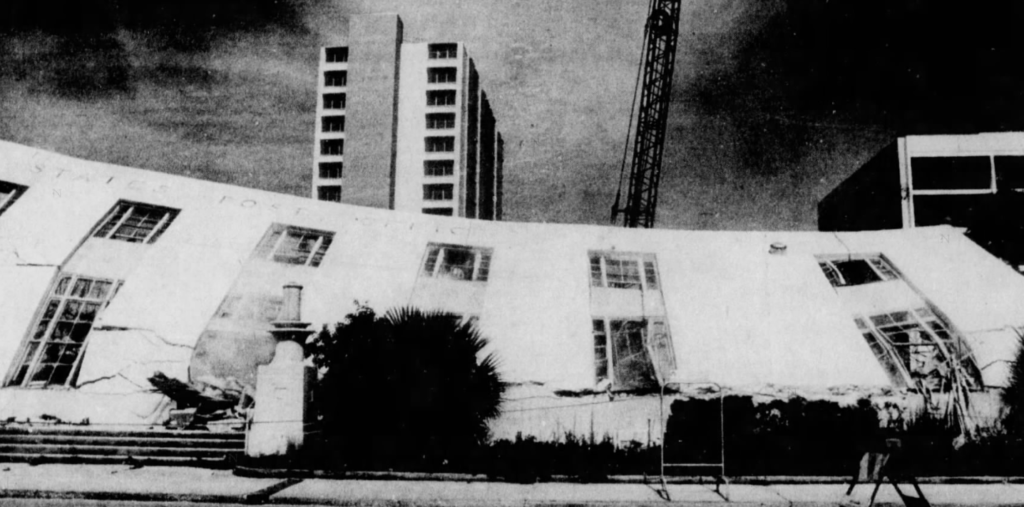
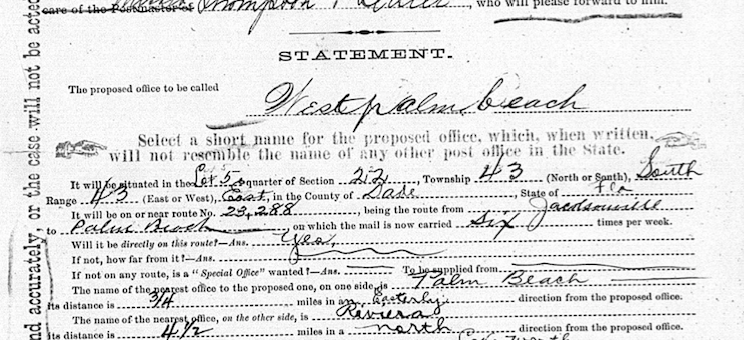
My father’s beat as a WPB Police Officer was in front of the 1936 Post Office Building. I began my lifelong hobby of stamp collecting at this post office. The original Depression era murals were located in the building and have moved twice to their present location on Summit Blvd. There were only six murals. They offer a glimpse into the early postal history of WPB!